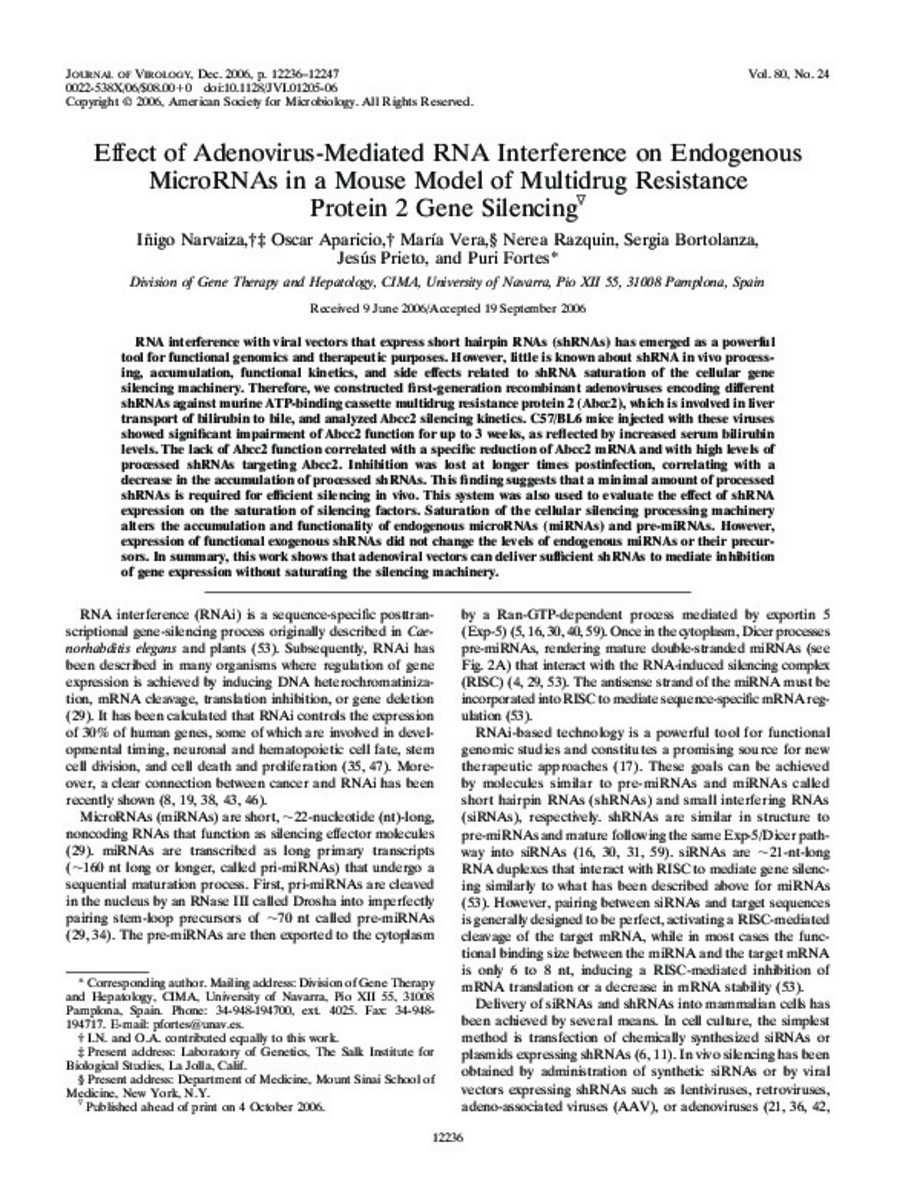Full metadata record
| DC Field | Value | Language |
|---|---|---|
| dc.creator | Narvaiza, I. (Íñigo) | - |
| dc.creator | Aparicio, O. (Óscar) | - |
| dc.creator | Vera, M. (María) | - |
| dc.creator | Razquin, N. (Nerea) | - |
| dc.creator | Bortolanza, S. (Sergia) | - |
| dc.creator | Prieto, J. (Jesús) | - |
| dc.creator | Fortes, P. (Puri) | - |
| dc.date.accessioned | 2012-09-06T11:53:18Z | - |
| dc.date.available | 2012-09-06T11:53:18Z | - |
| dc.date.issued | 2006 | - |
| dc.identifier.citation | Narvaiza I, Aparicio O, Vera M, Razquin N, Bortolanza S, Prieto J, et al. Effect of adenovirus-mediated RNA interference on endogenous microRNAs in a mouse model of multidrug resistance protein 2 gene silencing. J Virol 2006 Dec;80(24):12236-12247. | es_ES |
| dc.identifier.issn | 1098-5514 | - |
| dc.identifier.uri | https://hdl.handle.net/10171/23097 | - |
| dc.description.abstract | RNA interference with viral vectors that express short hairpin RNAs (shRNAs) has emerged as a powerful tool for functional genomics and therapeutic purposes. However, little is known about shRNA in vivo processing, accumulation, functional kinetics, and side effects related to shRNA saturation of the cellular gene silencing machinery. Therefore, we constructed first-generation recombinant adenoviruses encoding different shRNAs against murine ATP-binding cassette multidrug resistance protein 2 (Abcc2), which is involved in liver transport of bilirubin to bile, and analyzed Abcc2 silencing kinetics. C57/BL6 mice injected with these viruses showed significant impairment of Abcc2 function for up to 3 weeks, as reflected by increased serum bilirubin levels. The lack of Abcc2 function correlated with a specific reduction of Abcc2 mRNA and with high levels of processed shRNAs targeting Abcc2. Inhibition was lost at longer times postinfection, correlating with a decrease in the accumulation of processed shRNAs. This finding suggests that a minimal amount of processed shRNAs is required for efficient silencing in vivo. This system was also used to evaluate the effect of shRNA expression on the saturation of silencing factors. Saturation of the cellular silencing processing machinery alters the accumulation and functionality of endogenous microRNAs (miRNAs) and pre-miRNAs. However, expression of functional exogenous shRNAs did not change the levels of endogenous miRNAs or their precursors. In summary, this work shows that adenoviral vectors can deliver sufficient shRNAs to mediate inhibition of gene expression without saturating the silencing machinery. | es_ES |
| dc.language.iso | eng | es_ES |
| dc.publisher | American Society for Microbiology | es_ES |
| dc.rights | info:eu-repo/semantics/openAccess | es_ES |
| dc.subject | Gene Silencing | es_ES |
| dc.subject | MicroRNAs/genetics | es_ES |
| dc.subject | P-Glycoproteins/metabolism | es_ES |
| dc.subject | RNA Interference | es_ES |
| dc.title | Effect of adenovirus-mediated RNA interference on endogenous microRNAs in a mouse model of multidrug resistance protein 2 gene silencing | es_ES |
| dc.type | info:eu-repo/semantics/article | es_ES |
| dc.relation.publisherversion | http://jvi.asm.org/content/80/24/12236 | es_ES |
| dc.type.driver | info:eu-repo/semantics/article | es_ES |
Files in This Item:
Statistics and impact
Items in Dadun are protected by copyright, with all rights reserved, unless otherwise indicated.






